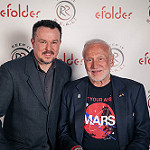
Selected by NASA in 1963 into the third group of astronauts, Buzz Aldrin was the first with a doctorate and became known as “Dr. Rendezvous.” The docking and rendezvous techniques he devised for spacecraft in Earth and lunar orbit because critical to the success of the Gemini and Apollo programs, and are still used today. He also poineered underwater training techniques, as a substitute for zero-gravity flights, to simulate spacewalking. In 1966, on the Gemini 12 orbital mission, Buzz performed the world’s first successful spacewalk, overcoming prior difficulties experienced by Americans and Russians during extra-vehicular activity (EVA), and setting a new EVA record of 5 1/2 hours. On July 20, 1969, Buzz and Neil Armstrong made their historic Apollo 11 moonwalk, becoming the first two humans to set foot on another world. An estimated 600 million people – at the time, the world’s largest television audience in history – witnessed this unprecedented herioc endeavor.
Dr. Aldrin is the author of nine books, including his New York Times best-selling autobiography, Magnificent Desolation, which was released in 2009 just before the 40th anniversary of the Apollo II moon landing. He continues to inspire today’s youth with his illustrated children’s books: Reaching for the Moon, another New York Times best-seller, and Look to the Stars, and recently released Welcome to Mars: Making a Home on the Red Planet. He has also authored two space science-fiction novels: The Return and Encounter with Tiber. His nonfiction works include the best-seller historical documentary, Men from Earth, and an early 1970’s autobiography, Return to Earth. His book, Mission to Mars: My Vision for Space Exploration, published by the National Geographic Society in 2013, outlines his plan to get us beyond the moon and on to Mars. As one of the leading space exploration advocates, Buzz continues to chart a course for future space travel and is passionate about inspiring the younger generations of future explorers and innovators.



